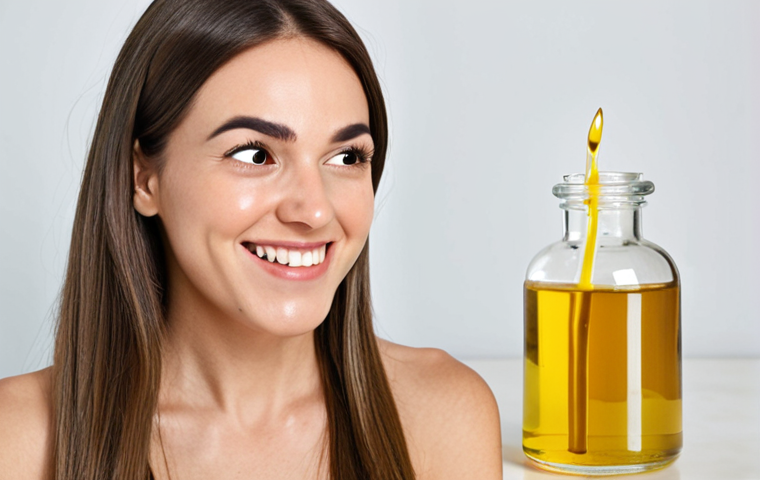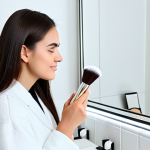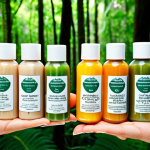Navigating the world of natural cosmetics can feel like wandering through a lush, but confusing, forest. With so many products boasting “natural” ingredients, it’s tough to know what’s truly good for your skin and your health.
I’ve been down that road myself, squinting at labels and wondering if that fancy-sounding botanical extract was really worth the hype. The sheer volume of choices, combined with clever marketing, can make it a real challenge to find the gems that actually deliver on their promises.
Plus, with new ingredients and formulations emerging all the time, staying on top of the latest trends in natural beauty feels like a full-time job. What’s the latest buzzed-about plant extract?
Is “clean beauty” actually regulated? What’s the deal with microbiome-friendly skincare? These are just a few of the questions swirling around my head as I try to make informed decisions.
With the rise of personalized skincare and AI-powered beauty tools, understanding how these technologies intersect with natural ingredients is also becoming increasingly important.
Let’s delve deeper and find out more about what to look for when purchasing natural cosmetics below!
Navigating the world of natural cosmetics can feel like wandering through a lush, but confusing, forest. With so many products boasting “natural” ingredients, it’s tough to know what’s truly good for your skin and your health.
I’ve been down that road myself, squinting at labels and wondering if that fancy-sounding botanical extract was really worth the hype. The sheer volume of choices, combined with clever marketing, can make it a real challenge to find the gems that actually deliver on their promises.
Plus, with new ingredients and formulations emerging all the time, staying on top of the latest trends in natural beauty feels like a full-time job. What’s the latest buzzed-about plant extract?
Is “clean beauty” actually regulated? What’s the deal with microbiome-friendly skincare? These are just a few of the questions swirling around my head as I try to make informed decisions.
With the rise of personalized skincare and AI-powered beauty tools, understanding how these technologies intersect with natural ingredients is also becoming increasingly important.
Let’s delve deeper and find out more about what to look for when purchasing natural cosmetics below!
Deciphering the Label Lingo: What “Natural” Really Means

The word “natural” gets thrown around a lot, but it doesn’t always mean what you think it does. There’s no strict legal definition for “natural” in the cosmetics industry in the US, which means companies can use it pretty loosely.
It’s up to us as consumers to be savvy and look beyond the buzzwords. I remember grabbing a shampoo once that screamed “natural” on the front, only to flip it over and find a bunch of synthetic ingredients I couldn’t even pronounce.
It’s a bit of a wild west out there!
Understanding Ingredient Lists
Take the time to actually read the ingredient list. Ingredients are listed in descending order by concentration, so the first few ingredients make up the bulk of the product.
Look for plant-based oils, botanical extracts, and essential oils near the top of the list. Be wary of long lists filled with chemical names you don’t recognize.
A good rule of thumb: if you can’t pronounce it, you might want to research it further. I always keep a search engine open on my phone while browsing the beauty aisle so I can quickly look up ingredients I’m not familiar with.
Certifications to Look For
Seek out certifications from reputable organizations like Ecocert, COSMOS, or the Natural Products Association. These certifications ensure that the product meets certain standards for natural and organic ingredients.
Seeing that little logo on the packaging gives me a lot more confidence that I’m actually getting what I pay for. It’s like a little seal of approval that someone else has done the homework for me.
Beware of “Greenwashing”
“Greenwashing” is when companies try to make their products appear more natural or environmentally friendly than they actually are. Watch out for vague claims like “naturally inspired” or “with natural extracts” without any real commitment to natural ingredients.
Don’t be fooled by pretty packaging or nature-themed imagery. Do your research and dig deeper to see what’s really inside the bottle.
Diving into Ingredient Quality and Sourcing
The source and quality of the ingredients matter just as much as whether or not they’re “natural.” Where ingredients come from, how they’re processed, and how sustainably they’re harvested all impact the final product and its effect on your skin and the environment.
I once splurged on a rosehip oil that claimed to be “wild harvested,” only to later learn that the harvesting practices were actually damaging to the local ecosystem.
It was a costly lesson in the importance of ethical sourcing!
Organic vs. Wildcrafted
Organic ingredients are grown without synthetic pesticides or fertilizers, which is great for your skin and the environment. Wildcrafted ingredients are harvested from their natural habitat, which can be a sustainable option if done responsibly.
However, wildcrafting can also lead to overharvesting and habitat destruction if not managed carefully. Look for companies that are transparent about their sourcing practices and prioritize sustainability.
Cold-Pressed Oils
Cold-pressed oils are extracted without the use of heat, which helps to preserve their beneficial properties. Heat can damage delicate nutrients and antioxidants, so cold-pressed oils are generally considered to be of higher quality.
You’ll often see this touted on labels for oils like argan, rosehip, and jojoba.
Fair Trade Practices
Consider whether the company supports fair trade practices. Fair trade ensures that farmers and producers in developing countries receive fair prices for their ingredients and are treated ethically.
This is especially important for ingredients like shea butter, cocoa butter, and certain essential oils. Supporting fair trade is a way to vote with your wallet and make a positive impact on the world.
Understanding Your Skin Type and Concerns
Just because a product is natural doesn’t mean it’s right for everyone. It’s crucial to choose products that are suited to your individual skin type and concerns.
What works wonders for one person might cause irritation for another. I learned this the hard way when I tried a natural face mask that was all the rage, only to end up with a red, itchy face for days!
Identifying Your Skin Type
Determine whether you have dry, oily, combination, or sensitive skin. Each skin type has different needs and responds differently to various ingredients.
Dry skin, for example, benefits from rich, moisturizing oils like shea butter and coconut oil, while oily skin might prefer lighter, non-comedogenic oils like jojoba and grapeseed oil.
Addressing Specific Skin Concerns
Look for products that target your specific skin concerns, such as acne, aging, or hyperpigmentation. Certain natural ingredients, like tea tree oil and salicylic acid, can be effective for treating acne, while antioxidants like vitamin C and green tea extract can help to protect against aging.
Patch Testing New Products
Always patch test new products on a small area of skin before applying them to your entire face. This will help you identify any potential allergies or sensitivities.
Apply a small amount of the product to your inner arm or behind your ear and wait 24-48 hours to see if any irritation occurs.
Exploring Key Natural Ingredients and Their Benefits
Familiarizing yourself with some of the most common and beneficial natural ingredients can help you make more informed choices. Knowing what to look for can empower you to select products that will truly nourish and improve your skin.
Think of it as building your own personal natural skincare dictionary!
Popular Plant-Based Oils
* Jojoba Oil: Closely resembles the skin’s natural sebum, making it a great moisturizer for all skin types. * Argan Oil: Rich in antioxidants and fatty acids, helps to hydrate and protect the skin.
* Rosehip Oil: Contains vitamin A and C, helps to reduce the appearance of scars and wrinkles. * Coconut Oil: Highly moisturizing, but can be comedogenic for some skin types.
Beneficial Botanical Extracts
* Aloe Vera: Soothes and hydrates the skin, helps to heal sunburns and minor irritations. * Green Tea Extract: Rich in antioxidants, helps to protect against free radical damage and reduce inflammation.
* Chamomile Extract: Calming and soothing, helps to reduce redness and irritation. * Calendula Extract: Anti-inflammatory and wound-healing properties, good for sensitive skin.
Essential Oils for Skincare
* Lavender Oil: Calming and relaxing, helps to reduce stress and promote sleep. * Tea Tree Oil: Antiseptic and anti-inflammatory, effective for treating acne.
* Rosemary Oil: Stimulating and invigorating, helps to improve circulation. * Frankincense Oil: Rejuvenating and anti-aging, helps to reduce the appearance of wrinkles.
Considering the Environmental Impact
Choosing natural cosmetics is not just about what you put on your skin, it’s also about the impact your choices have on the planet. Sustainable packaging, ethical sourcing, and cruelty-free practices are all important factors to consider.
I’ve started paying much closer attention to the packaging of my skincare products, and I’m trying to switch to brands that use recycled or biodegradable materials.
Sustainable Packaging Options
Look for products packaged in recyclable materials like glass or aluminum, or biodegradable materials like paper or plant-based plastics. Avoid products with excessive packaging or single-use plastics.
Cruelty-Free Certifications
Ensure that the products you choose are cruelty-free and not tested on animals. Look for certifications from organizations like Leaping Bunny or PETA.
Supporting Eco-Conscious Brands
Choose brands that are committed to sustainability and ethical practices. Many companies are now taking steps to reduce their environmental footprint and support social responsibility initiatives.
Cost vs. Value: Finding the Right Balance
Natural cosmetics can sometimes be more expensive than conventional products, but it’s important to consider the long-term value. Investing in high-quality, natural products can be better for your skin, your health, and the environment.
However, you don’t have to break the bank to find effective natural skincare.
Comparing Prices and Ingredients
Compare the prices of different products and look closely at the ingredient lists to see what you’re actually paying for. Sometimes, a less expensive product with a simpler ingredient list can be just as effective as a more expensive product with a lot of fancy extras.
DIY Options
Consider making your own natural skincare products at home. There are many simple recipes online for things like face masks, scrubs, and toners. This can be a fun and cost-effective way to control exactly what goes on your skin.
Investing in Key Products
Focus your budget on key products that you use every day, like cleanser, moisturizer, and sunscreen. You can save money on less essential items like toners and serums.
Here’s a handy table to summarize some key points:
| Checklist | Description | Why it Matters |
|---|---|---|
| Ingredient List | Prioritize plant-based oils and extracts. | Avoid harsh chemicals and synthetic additives. |
| Certifications | Look for Ecocert, COSMOS, Natural Products Association. | Ensures adherence to natural and organic standards. |
| Ethical Sourcing | Support fair trade and sustainable harvesting practices. | Promotes ethical treatment of farmers and environmental responsibility. |
| Skin Type | Choose products tailored to your specific skin type (dry, oily, sensitive). | Avoid irritation and maximize effectiveness. |
| Packaging | Opt for recyclable or biodegradable packaging. | Reduces environmental impact and waste. |
The Role of Customer Reviews and Recommendations
Don’t underestimate the power of customer reviews and recommendations. Reading what other people have to say about a product can provide valuable insights into its effectiveness, safety, and overall quality.
However, it’s important to take reviews with a grain of salt and consider the source.
Seeking Out Authentic Reviews
Look for reviews from reputable sources, such as beauty blogs, online forums, and customer reviews on e-commerce websites. Be wary of fake or biased reviews.
Considering Multiple Perspectives
Read a variety of reviews to get a well-rounded perspective on the product. Pay attention to both positive and negative feedback.
Trusting Your Gut
Ultimately, the best way to determine if a product is right for you is to try it yourself. Trust your gut and choose products that align with your values and preferences.
Navigating the natural beauty world can be overwhelming, but with a little knowledge and awareness, you can make informed choices that benefit your skin and the planet.
Remember to read labels carefully, prioritize quality ingredients, and consider your own skin type and concerns. Don’t be afraid to experiment and find what works best for you.
After all, skincare should be a joyful and empowering experience!
In Conclusion
Embarking on your natural skincare journey is an exciting adventure! It’s all about educating yourself, being mindful of ingredients, and making choices that align with your personal values. Remember, there’s no one-size-fits-all solution, so embrace experimentation, listen to your skin, and enjoy the process of discovering what truly works for you.
By staying informed and making conscious decisions, you can create a skincare routine that not only enhances your natural beauty but also contributes to a healthier planet.
So go ahead, explore the world of natural cosmetics with confidence and let your skin radiate with the glow of mindful beauty!
Useful Information
1. Check Expiry Dates: Natural products often have shorter shelf lives due to the absence of synthetic preservatives. Always check the expiry date before purchasing and using a product.
2. Storage Matters: Proper storage can significantly extend the lifespan of your natural cosmetics. Keep products away from direct sunlight, heat, and humidity. Cool, dark places like a cabinet or drawer are ideal.
3. Listen to Your Skin: Pay attention to how your skin reacts to different products and ingredients. If you experience any irritation or adverse reactions, discontinue use immediately and consult a dermatologist.
4. Read the fine print: Don’t be afraid to contact customer service or ask for additional details if you’re unsure about any aspects of a natural product.
5. Start Simple: Transitioning to natural skincare doesn’t have to be an all-or-nothing endeavor. Start by swapping out one or two products at a time, such as your cleanser or moisturizer, and gradually build your natural skincare routine.
Key Takeaways
When choosing natural cosmetics, prioritize understanding ingredient lists, seeking certifications, considering ethical sourcing, matching products to your skin type, and opting for sustainable packaging.
Frequently Asked Questions (FAQ) 📖
Q: What does “natural” actually mean when it comes to cosmetics, and is there any official regulation behind the term?
A: Ah, “natural” – the million-dollar question! Honestly, the term is incredibly vague in the beauty industry. Unlike “organic” in the food world, there’s no single, universally accepted legal definition for “natural” cosmetics in the US or UK.
This means a product can be labeled “natural” even if it contains only a small percentage of natural ingredients alongside synthetic ones. It’s really up to the brand to define what “natural” means to them, which, as you can imagine, leads to a whole lot of greenwashing.
To be extra sure, I always check for certifications from organizations like COSMOS, ECOCERT, or the Natural Products Association, but even then, it’s wise to do your own research into the ingredient list.
Don’t just take the front label at face value!
Q: I have super sensitive skin.
A: re natural cosmetics always gentler or less likely to cause irritation than conventional products? A2: That’s a great question! You’d think “natural” automatically equals “gentle,” but that’s definitely not always the case.
Some natural ingredients, like certain essential oils (tea tree, lavender) or even plant extracts (witch hazel), can be quite potent and irritating for sensitive skin.
I learned that the hard way after slathering on a supposedly calming “natural” face mask that left my face red as a tomato! It’s really about understanding your skin and identifying ingredients that you know don’t agree with it.
Always do a patch test before using a new product all over your face, even if it’s marketed as “natural” or “hypoallergenic.” Look for products specifically formulated for sensitive skin, and keep an eye out for calming ingredients like aloe vera, chamomile, or colloidal oatmeal.
Less is often more when it comes to sensitive skin!
Q: Are natural cosmetics always more expensive than conventional ones, and if so, why?
A: re there ways to find affordable options? A3: You’re right, natural cosmetics often come with a heftier price tag, and there are a few reasons for that.
Sourcing high-quality, sustainably harvested natural ingredients can be more costly than using synthetic alternatives. Plus, smaller, independent brands that focus on natural formulations often have higher overhead costs compared to massive corporations.
However, don’t despair! You don’t have to break the bank to go natural. I’ve found that many drugstore brands are starting to incorporate more natural ingredients into their products, and you can often find affordable options that are free of harsh chemicals.
Keep an eye out for sales and discounts, and consider making some of your own DIY beauty products using simple, natural ingredients. Things like honey masks or oatmeal scrubs are super easy to make and can be just as effective as expensive store-bought options!
You can also check out sites like Credo Beauty and The Detox Market, which focus on curating cleaner and more natural brands, and they often have sale events.
📚 References
Wikipedia Encyclopedia
구글 검색 결과
구글 검색 결과
구글 검색 결과
구글 검색 결과






